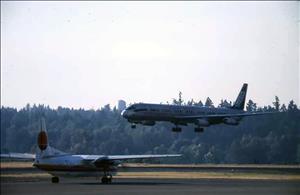On December 28, 1988, the Port of Seattle publishes a “Comprehensive Planning Review and Airspace Update Study.” This study concludes that the existing two runways at Seattle-Tacoma (Sea-Tac) International Airport could reach “maximum efficient capacity” by the year 2000, raising for the first time the idea of constructing a third “dependent” runway.
Crowded Sky
Seattle-Tacoma Airport opened with one runway in 1944 and became fully operational in 1949. An additional runway was built 800 feet to the west in 1970 to accommodate increased air traffic and larger jetliners. This narrow separation prevented the use of both runways during fog and low clouds, or about 44 percent of the time, and capped the airport’s efficient capacity with minimum delays at about 380,000 operations (landings and takeoffs) per year.
Deregulation of U.S. airlines in 1978 stimulated competition within the airline industry and more than doubled the number of major carriers using Sea-Tac’s two runways. Airport operations grew by half again from 195,000 operations to 316,000 operations in 1988, while annual passenger counts nearly doubled from 8.4 million to 14.5 million during the same period. Port planners projected that Sea-Tac could reach 400,000 annual operations by 2000, resulting in significant flight delays during times of limited visibility. (Sea-Tac operations passed 385,000 in 1997 and peaked at nearly 446,000 in 2000 but then declined to 365,000 in 2002 due to slumps in the economy and national air travel after the September 11, 2001, attacks.)
The Puget Sound Council of Governments (reorganized as the Puget Sound Regional Council in 1991) reached the same conclusion about the limited ability of Sea-Tac International Airport to meet the region’s growing air transportation needs with current facilities. Their findings were published as the “Regional Airport System Plan,” adopted by the Council under Resolution A-88-13 on September 29, 1988. The following year, the Federal Aviation Administration (FAA) published the “Seattle-Tacoma International Airport Capacity Plan.” This plan mirrored the findings of the Port and the Council.
"Flight Plan" Takes Off
In 1989, the Council and the Port immediately launched what was known as the “Flight Plan” process. A special Puget Sound Air Transportation Committee (PSATC) conducted this extensive three-year investigation into possible solutions for Sea-Tac International Airport’s runway crisis.
The Flight Plan attempted to address the following questions:
1. What are the major implications and trade-offs between regional alternatives?
2. What is the probable long-term demand for commercial transportation?
3. What are the alternative regional air transportation systems?
4. What are the impacts with respect to noise, air quality, land use, and other community factors?
5. How does commercial air transportation capacity relate to other regional planning activities?
Birth of the Third Runway
The hallmark of the Flight Plan process was extensive public outreach, including 26 PSATC public working sessions, 11 Port of Seattle public working meetings, 6 PSATC open house/scoping meetings throughout the region, and 4 final PSATC public comment meetings.
After examining many other options, the Puget Sound Regional Council, FAA, and Port concluded in 1996 that the addition of a third “dependent” runway to Sea-Tac for bad-weather use offered the best approach to meet projected regional air-capacity needs. The project met determined opposition from nearby communities and environmental groups, but in May 2004, the State Supreme Court largely cleared the way for construction to resume, and on August 19, 2004, the Airport Communities Coalition dropped litigation.
The third runway was completed in 2008 at a cost of more than $1 billion.

